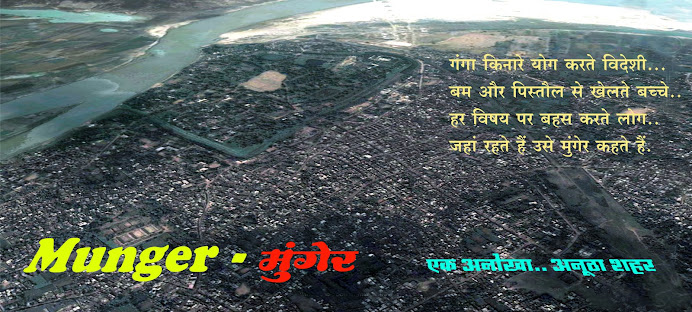 Ganges river[citation needed].
Ganges river[citation needed].Monghyr was a town and district of British India, in the Bhagalpur division of Bengal.
The town is on the right bank of the Ganges, and has a railway station, with steam ferry service to the railway on the opposite bank of the river. In 1195 Monghyr, a fortress of great natural strength, appears to have been taken by Muhammad Bin Bakhtiyar Khalji, the first Moslem conqueror of Bengal. Henceforth it is often mentioned by the Mohammedan chroniclers as a place of military importance, and was frequently chosen as the seat of the local government. After 1590, when Akbar established his supremacy over the Afghan chiefs of Bengal, Monghyr was long the headquarters of his general, Todar Mal; and it also figures prominently during the rebellion of Shāh Shujā against his brother, Aurangzeb. In more recent times Nawab Mir Kasim, in his war with the English, selected it as his residence and the centre of his military preparations.
Munger is the place where Karna resided in antiquity. In the Mahabharata, Karna is often referred to as "Angraj" (The King of Ang). In ancient times, Munger was known as Ang[citation needed]. The name is also cemented by the fact that the local language spoken in Munger is known as "Angika". Based on the Mahabharata's evidence, the kingdom of the Angas roughly corresponded to the region of Bhagalpur and Monghyr in Bihar and parts of Bengal, and later extended to include most of Bengal. According to the Mahabharata, Duryodhana had named Karna the King of Anga.
Sabhaparava of Mahabharata (II.44.9) mentions Anga and Vanga as forming one country. The Katha-Sarit-Sagara also attests that Vitankapur, a city of Anga, was situated on the shores of the sea. Thus the boundaries of Anga may have extended to the sea in the east.
Anga and Vanga as forming one country. The Katha-Sarit-Sagara also attests that Vitankapur, a city of Anga, was situated on the shores of the sea. Thus the boundaries of Anga may have extended to the sea in the east.
The first railway from Howrah ran through Monghyr: this East Indian Railway line opened to Monghyr in 1861. After the disastrous earthquake of 1934 the town was rebuilt to give it a modern look, but in keeping with its history. Munger has also been made famous by "The Bihar School of Yoga" set up by the revered [Swami Nityanand Saraswati].
Munger is the place where Karna resided in antiquity. In the Mahabharata, Karna is often referred to as "Angraj" (The King of Ang). In ancient times, Munger was known as Ang[citation needed]. The name is also cemented by the fact that the local language spoken in Munger is known as "Angika". Based on the Mahabharata's evidence, the kingdom of the Angas roughly corresponded to the region of Bhagalpur and Monghyr in Bihar and parts of Bengal, and later extended to include most of Bengal. According to the Mahabharata, Duryodhana had named Karna the King of Anga.
Sabhaparava of Mahabharata (II.44.9) mentions
 Anga and Vanga as forming one country. The Katha-Sarit-Sagara also attests that Vitankapur, a city of Anga, was situated on the shores of the sea. Thus the boundaries of Anga may have extended to the sea in the east.
Anga and Vanga as forming one country. The Katha-Sarit-Sagara also attests that Vitankapur, a city of Anga, was situated on the shores of the sea. Thus the boundaries of Anga may have extended to the sea in the east.The first railway from Howrah ran through Monghyr: this East Indian Railway line opened to Monghyr in 1861. After the disastrous earthquake of 1934 the town was rebuilt to give it a modern look, but in keeping with its history. Munger has also been made famous by "The Bihar School of Yoga" set up by the revered [Swami Nityanand Saraswati].



your history about munger is very informative,but i wanna know who were the rajput kings ruling at the time of disasterous earthquake of 1934.I will be thankful to you if you give some information on this.
ReplyDeleteRaja Puran Mal of Gidhaur was a Rajput and had a palace(with a dome) with plenty of land and a pokhar around it; the palace was almost completely destroyed in the earthquake on 14th January 1934.The landholdings,including the pokhar(Lallu Pokhar) were, around 1958, purchased by our family.
ReplyDeleteAs a child then I have seen the remnants, including a part of the dome.
pksinha7@gmail.com
BRE BHI SAHAB AAP KA BLOG PDA PD KER ACHA LAGA THANKS
ReplyDeletemunger is my distric & i love munger & here people
ReplyDeleteKindly correct the last sentance of your post on MUNGER. Founder of Bihar School of Yoga is Swami Satyananda Saraswati. BSY has placed name of Munger town on world map. Yoga Nagri (City of Yoga) is the name given to it by Dr. A P J Abdul Kalam, former President of Indian Republic. Thanks!
ReplyDelete